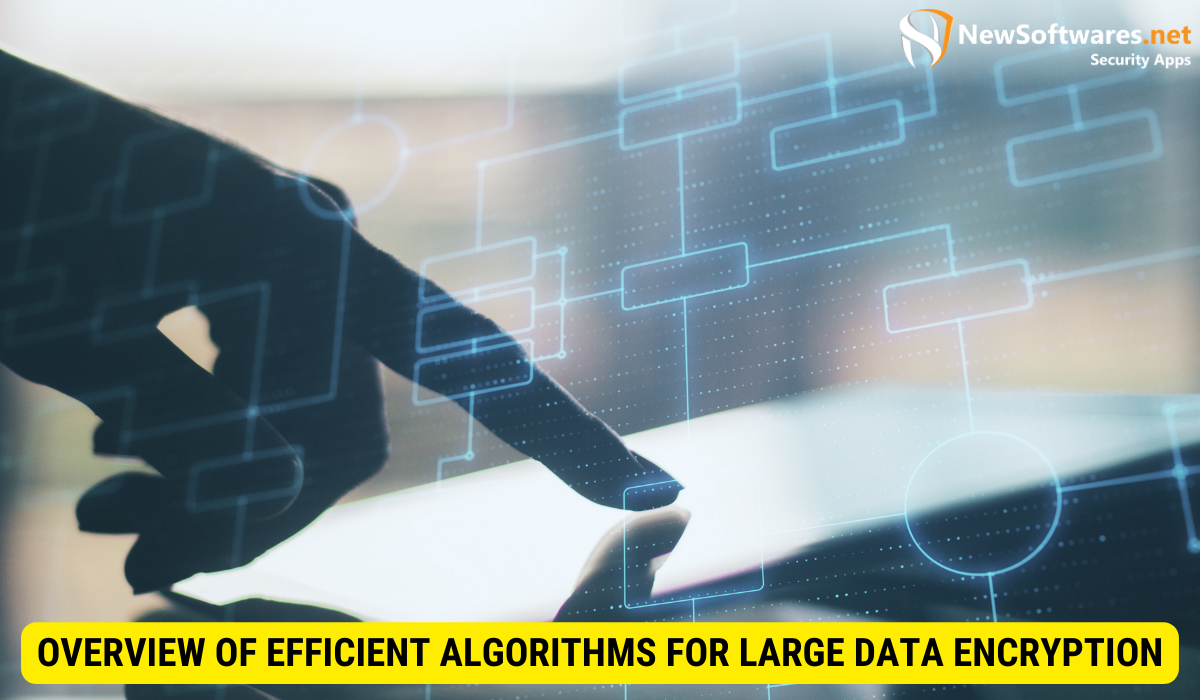Efficient algorithms for large data encryption optimize performance when dealing with substantial datasets, ensuring data security.
In today’s digital age, data security has become a paramount anxiety for individuals and organizations alike. With the increasing volume of data being generated and transmitted, the need to protect sensitive information from illegal access has never been more critical. Encryption, the process of changing plain text into unreadable ciphertext, provides a robust means of safeguarding data. However, when dealing with large volumes of data, traditional encryption methods often fall short in terms of efficiency and security. Together, we will delve into the realm of efficient algorithms for large data encryption and explore the intricacies of this vital field.
Understanding the Basics of Data Encryption

Data encryption is the process of converting information into an indecipherable format, making it accessible only to authorized parties who possess the corresponding decryption key. The primary objective of encryption is to ensure data confidentiality, integrity, and authenticity. By encrypting data, organizations can mitigate the risk of illegal access and maintain the privacy of sensitive information.
Data encryption has become an essential component of modern-day security measures. With the rising prevalence of cyber threats and data breaches, organizations are recognizing the critical importance of protecting their data. Encryption provides a powerful defense mechanism, making it very difficult for unauthorized individuals to access and interpret sensitive information. This is particularly vital for industries that deal with highly confidential data, such as financial institutions, healthcare organizations, and government agencies.
The Importance of Data Encryption
Data encryption is of utmost importance in today’s interconnected world. The propagation of cyber threats and data breaches emphasizes the need for robust security measures. By encrypting data, organizations can prevent unauthorized individuals from accessing and interpreting sensitive information. Moreover, encryption plays a crucial role in maintaining regulatory compliance, like (GDPR) the General Data Protection Regulation & (HIPAA) the Health Insurance Portability and Accountability Act.
One of the key benefits of data encryption is the assurance it provides in maintaining data confidentiality. When data is encrypted, it becomes virtually impossible for unauthorized parties to decipher the information without the corresponding decryption key. This makes certain that even if a breach occurs, the stolen data remains useless to the attackers.
Data integrity is another critical aspect that encryption addresses. Encryption algorithms include mechanisms to detect any tampering or modifications made to the encrypted data. By verifying the integrity of the data, organizations can ensure that the information has not been altered in transit or storage, maintaining its accuracy and reliability.
Moreover, data encryption plays a vital role in establishing data authenticity. By encrypting data, organizations can verify the origin and integrity of the information. This is particularly important in scenarios where data is exchanged between different parties, as encryption provides a means to validate the source and ensure that the data has not been tampered with during transmission.
Key Concepts in Data Encryption
Before delving into the world of efficient algorithms for large data encryption, it is crucial to grasp a few key concepts. The two fundamental types of encryption algorithms used are symmetric encryption and asymmetric encryption. Symmetric encryption employs a single key, which is used for both encryption and decryption of data. On the other hand, asymmetric encryption utilizes a pair of keys, namely a public key for encryption and a private key for decryption.
Symmetric encryption algorithms, Like Advanced Encryption Standard (AES), are known for their efficiency and speed. They are commonly used for encrypting large volumes of data, as they require less computational resources compared to asymmetric encryption algorithms. However, the challenge with symmetric encryption lies in securely sharing the encryption key between the sender and the recipient.
Asymmetric encryption, also known as public-key encryption, addresses the key sharing challenge by using a pair of keys. The public key is used for encryption, while the confidential key is kept top secret and used for decryption. This approach eliminates the need for securely sharing a single key, making it more suitable for scenarios where secure communication is required between multiple parties.
Understanding these key concepts in data encryption lays the foundation for implementing effective security measures. By selecting the appropriate encryption algorithms and understanding their strengths and limitations, organizations can ensure the confidentiality, integrity, and authenticity of their data.
Exploring Different Types of Encryption Algorithms
Encryption algorithms form the backbone of the encryption process. Numerous encryption algorithms are available, each with its unique characteristics and functionalities. Let’s take a closer look at symmetric and asymmetric encryption algorithms.
Symmetric Encryption Algorithms
Symmetric encryption algorithms, also known as secret key algorithms, employ the same key for both encryption and decryption. These algorithms are typically faster than their asymmetric counterparts due to their simplicity. Common examples of symmetric encryption algorithms involve the Data Encryption Standard (DES), (AES) Advanced Encryption Standard and Rivest Cipher (RC5).
Asymmetric Encryption Algorithms
Asymmetric encryption algorithms, also referred to as public-key algorithms, employ two distinct keys, namely a public key for encryption and a private key for decoding. This duality allows for secure communication between parties without the need to exchange a secret key. Notable examples of asymmetric encryption algorithms include the Rivest-Shamir-Adleman (RSA) algorithm and the Elliptic Curve Cryptography (ECC) algorithm.
The Challenge of Large Data Encryption
As the volume of data being generated continues to skyrocket, traditional encryption methods face significant challenges when encrypting large datasets. Inefficient encryption algorithms may lead to intolerable processing times and performance bottlenecks. To overcome these challenges, efficient algorithms for large data encryption have been developed.
Why Traditional Encryption Methods Fall Short
Traditional encryption algorithms, while effective for small to medium-sized datasets, struggle to scale when tasked with encrypting massive volumes of data. The computation and memory requirements of these algorithms become a limiting factor, leading to decreased efficiency and performance degradation.
The Need for Efficient Large Data Encryption
Efficient large data encryption algorithms address the inherent limitations of traditional methods and allow for the secure encryption and decryption of substantial datasets. These algorithms are designed to optimize performance while maintaining the desired level of data security. By leveraging advanced techniques and parallel processing, efficient algorithms offer a viable solution for enterprises handling extensive amounts of sensitive information.
Evaluating Efficiency in Encryption Algorithms
Efficiency is a critical factor when evaluating encryption algorithms for large data sets. Several factors influence the overall efficiency of an encryption algorithm, including computational complexity, memory utilization, and key management. It is essential to consider these elements to ensure a balance between security and performance.
Factors Determining Algorithm Efficiency
When selecting an efficient algorithm for large data encryption, some key factors to consider include the algorithm’s speed, scalability, and resource utilization. Algorithms that can process data quickly, scale seamlessly to handle higher volumes, and optimize resource usage are ideal for efficient large data encryption.
Measuring Encryption and Decryption Speed
Encryption and decryption speed are crucial metrics for evaluating the efficiency of encryption algorithms. Higher encryption and decryption speeds enable organizations to process large volumes of data more rapidly, ensuring productivity and operational effectiveness.
Overview of Efficient Algorithms for Large Data Encryption

Several efficient algorithms are specifically designed for large data encryption. Let’s explore a few notable examples:
Advanced Encryption Standard (AES)
AES, the successor to DES, is a widely adopted symmetric encryption algorithm. It offers robust security while maintaining exceptional performance. AES supports different key sizes and encryption modes, making it suitable for various applications requiring large data encryption.
RSA Algorithm
The RSA algorithm is a extensively used asymmetric encryption algorithm that employs the mathematical properties of prime numbers and modular arithmetic. It provides a secure means of exchanging information among parties without the need for a pre-shared secret key. RSA is highly flexible, making it suitable for large data encryption scenarios.
Elliptic Curve Cryptography (ECC)
ECC is an asymmetric encryption algorithm that leverages the mathematical properties of elliptic curves. It offers comparable security to traditional asymmetric algorithms while requiring smaller key sizes, resulting in increased computational efficiency. ECC is particularly well-suited for resource-constrained environments and is gaining popularity for large data encryption purposes.
Key Takeaways
- Data encryption is essential for ensuring the secrecy and integrity of sensitive information.
- Efficient algorithms for large data encryption address the challenges posed by traditional methods when dealing with substantial datasets.
- Symmetric encryption algorithms use the similar key for encryption and decryption, while asymmetric encryption algorithms employ a pair of keys.
- Evaluation of factors such as speed, scalability, and resource utilization is crucial when selecting an efficient algorithm for large data encryption.
- Notable examples of efficient algorithms for large data encryption include AES, RSA, and ECC.
Frequently Asked Questions
Why is large data encryption important?
Large data encryption ensures that sensitive information remains secure and inaccessible to unauthorized individuals.
How do efficient algorithms overcome the challenges of encrypting large datasets?
Efficient algorithms leverage advanced techniques and parallel processing to optimize performance and mitigate the limitations of traditional methods.
What factors determine the efficiency of encryption algorithms?
Speed, scalability, and resource utilization are key factors that influence the overall efficiency of encryption algorithms.
What is the Advanced Encryption Standard (AES) used for large data encryption?
AES provides robust security while offering flexibility in terms of key sizes and encryption modes, making it well-suited for large data encryption.
Why is Elliptic Curve Cryptography (ECC) gaining popularity?
ECC provides comparable security to traditional asymmetric algorithms while requiring smaller key sizes, resulting in increased computational efficiency, making it ideal for large data encryption in resource-constrained environments.
Conclusion
Efficient algorithms for large data encryption play a essential role in addressing the challenge faced by traditional encryption methods when dealing with substantial datasets. By leveraging advanced techniques and optimizing performance, these algorithms offer a viable solution for organizations looking to secure their sensitive information without sacrificing efficiency. It is critical for businesses to cautiously evaluate factors such as speed, scalability, and resource utilization when selecting an efficient algorithm for large data encryption. Notable examples such as AES, RSA, and ECC provide robust security while maintaining exceptional performance, making them suitable choices in a variety of encryption scenarios.
